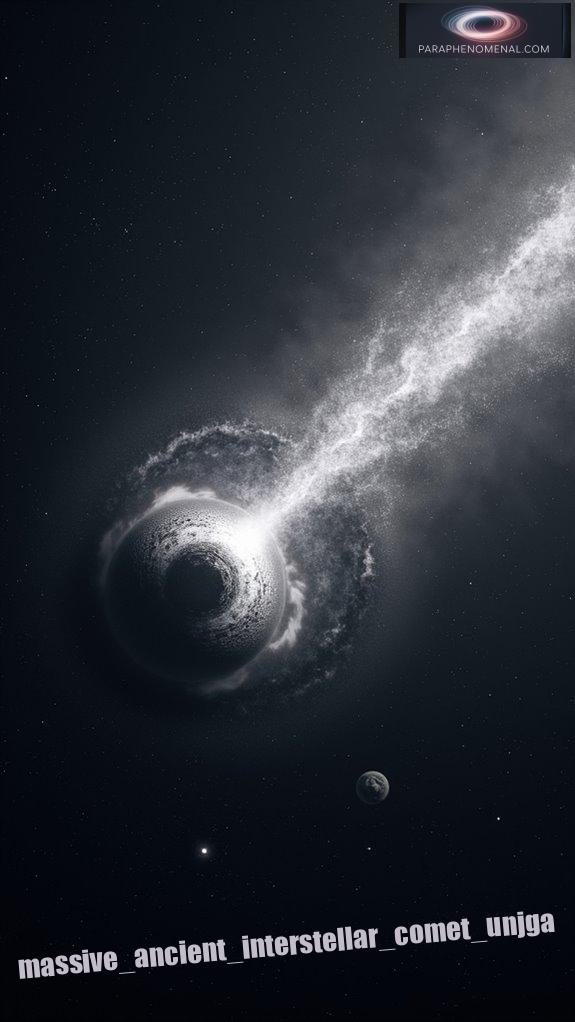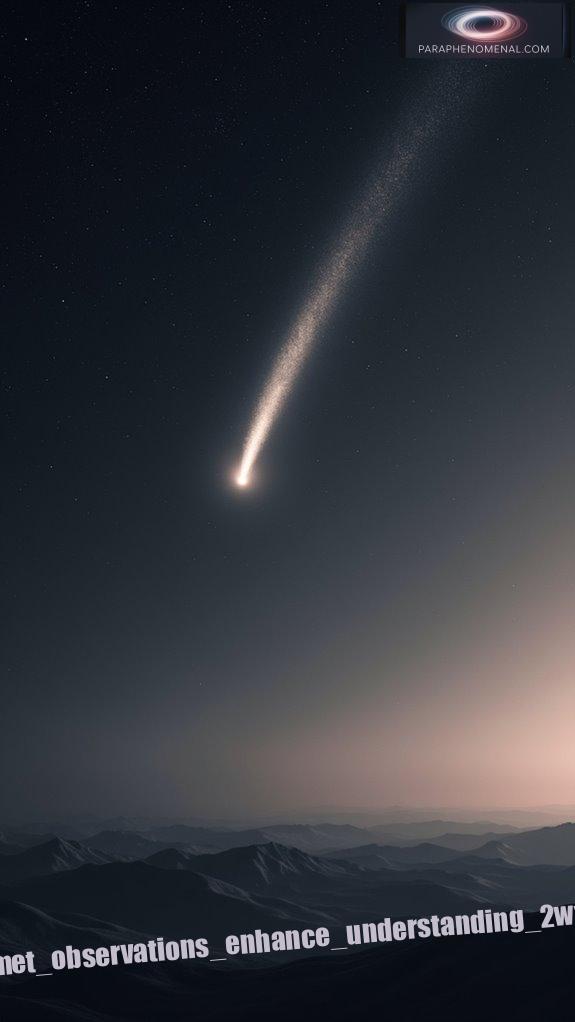Comet 3I/ATLAS is a fascinating enigma within our cosmic neighborhood.
As it zips along its unique hyperbolic path, diving out of our solar system, I can’t help but wonder about what secrets it holds.
With hints of volatile chemicals, including substantial amounts of water, this celestial traveler is not just a rock; it’s a potential key to extraterrestrial mysteries.
Observations from Hubble and ESA offer us rapid brightness changes captured in stunning detail.
What might future insights from Webb and SPHEREX unveil? Are we looking at a cosmic harbinger of life’s building blocks?
A Close Encounter with the Unexplained
I once had an unforgettable experience during a stargazing event.
While observing a meteor shower, I noticed an unusual light darting across the sky, unlike any shooting star.
Equipped with my camera, I captured a brief video of its erratic movements.
Later, I learned it could have been a satellite or perhaps something more elusive.
This mystery resonates with the ongoing quest of scientists as they investigate UFO activity and its link to celestial phenomena like comets and asteroids.
What if these objects are more than mere cosmic wanderers? Could they be signposts to something greater?
Quick Takeaways
- Comet 3I/ATLAS follows a hyperbolic trajectory, indicating a permanent exit from the solar system and high interstellar velocity of 221,000 km/h.
- Hubble’s Wide Field Camera captures the comet’s complex dust structures and active brightness changes, highlighting its volatile composition.
- ESA’s infrared instruments and SPHEREx are utilized for chemical analysis and thermal emissions, providing insights into the comet’s material composition.
- Observations from Mars orbiters complement Hubble’s data, revealing similarities to solar system comets and offering unique insights into 3I/ATLAS’s dynamics.
- Future observations from the James Webb Space Telescope will focus on high-resolution imaging and composition analysis, enhancing our understanding of 3I/ATLAS’s trajectory.
Characteristics of Comet 3I/ATLAS

When you look at Comet 3I/ATLAS, it becomes clear that it possesses some remarkable characteristics that set it apart from typical solar system comets.
Measuring about 3.5 miles wide, it might be the largest interstellar object ever observed. This massive comet’s estimated age is around 3 billion years old, predating our solar system. Its interstellar velocity is notably faster than typical comets, highlighting its extraordinary journey through space.
Early observations show it has a highly volatile composition, with substantial water content that sublimates even far from the Sun. Its brightness changes rapidly, indicating intense activity unlike static asteroids. Hints of metallic surface and unique light reflection suggest complex origins. Notably, its predicted magnitude is around 15.08, which signifies a unique brightness level that could be exciting for observers.
At ParaPhenomenal, we explore such fascinating phenomena to bring cosmic wonders closer to you.
Understanding 3I/ATLAS offers great understandings into objects that challenge our views of the universe.
The Hyperbolic Trajectory of 3I/ATLAS
The hyperbolic trajectory of Comet 3I/ATLAS reveals significant revelations about its journey through our solar system.
Detected by Hubble, its rapid, non-Keplerian path shows streaked background stars, indicating its exceptional speed of about 221,000 km/h. This motion confirms it’s too fast for solar gravity to bind, marking it as an interstellar object. Additionally, the unusual flight path of 3I/ATLAS enhances understanding of interstellar objects, showcasing how they differ from typical comets.
Classified as hyperbolic, it’ll permanently exit our solar system after perihelion on October 29, 2025. Moreover, the comet is expected to reach its closest approach to the Sun around October 30, 2025, emphasizing its transient nature.
Classified as hyperbolic, Comet 3I/ATLAS will make its permanent exit from our solar system post-perihelion on October 29, 2025.
These hyperbolic characteristics suggest it originated from interstellar space, not our solar system. As it nears the Sun, its speed will increase.
Understanding 3I/ATLAS enriches our knowledge of interstellar objects, which is vital for understanding into cosmic phenomena, a key interest of our website, ParaPhenomenal.
Imaging Techniques Utilized by Hubble and ESA
Comet 3I/ATLAS captivates astronomers not only with its unique trajectory but also with the advanced imaging techniques used by both the Hubble Space Telescope and the European Space Agency (ESA).
Hubble employs its Wide Field Camera to capture detailed images of the comet, revealing complex dust structures and tails. You’ll notice streaks in the images as the comet moves rapidly against the background stars. The comet’s high speed of 130,000 miles per hour is a result of drifting through interstellar space for billions of years.
ESA complements this with infrared instruments, detecting thermal emissions and chemical signatures from the comet’s nucleus. SPHEREx’s wide-field spectral surveys help identify molecular features in the coma.
With our goal of increasing understanding of celestial phenomena, we provide perspectives into how these impressive imaging tools work together, deepening our comprehension of 3I/ATLAS.
Insights Gained From Hubble and Mars Orbiter Observations

As 3I/ATLAS draws closer to its flyby of Mars, exciting new discoveries emerge from the combined observations of the Hubble Space Telescope and Mars orbiters.
Mars orbiters provide unique advantages, capturing detailed data as the comet approaches. Hubble’s measurements of the comet’s nucleus size and dust plume enhance our understanding of its activity, revealing similarities with solar system comets despite its interstellar origin. Additionally, the comet’s maximum orbital speed of 68.3 km/s at perihelion provides clues to its unusual dynamics.
You’ll find that Mars instruments offer longer viewing windows, allowing for in-depth analysis. Thermal measurements can assess the comet’s temperature and activity more effectively.
This synergy between Hubble and Mars observations gives us crucial perspectives into the comet’s dynamics, guiding future studies.
At ParaPhenomenal, we’re dedicated to exploring these fascinating cosmic phenomena, expanding our understanding of the universe.
Future Observations With Webb and SPHEREX
Future observations with the James Webb Space Telescope (JWST) and SPHEREX promise to enhance our understanding of comet 3I/ATLAS considerably. These advanced tools offer unique capabilities that will shed light on the comet’s composition, structure, and trajectory. You can expect significant revelations into the physical and chemical properties of 3I/ATLAS, deepening our knowledge of its origin.
| Telescope | Observation Type | Potential Revelations |
|---|---|---|
| JWST | Infrared Imaging | Composition analysis |
| SPHEREX | Spectroscopy | Chemical signatures |
| Both | Time-Domain Surveys | Trajectory changes |
| JWST | High-Resolution Imaging | Structural details |
| SPHEREX | Wide-Field Surveys | Population studies |
Keep an eye on mission announcements for updates on these thrilling campaigns!
FAQ
How Was Comet 3i/Atlas Discovered?
Comet 3I/ATLAS was discovered on July 1, 2025, by the ATLAS survey telescope in Chile.
It appeared as a faint object with an apparent magnitude of 18 and was initially 4.5 AU from the Sun, traveling at 61 km/s.
Its unusual hyperbolic trajectory suggested it came from outside our Solar System.
This discovery highlights the importance of global collaboration among astronomers, a focus of our website, ParaPhenomenal, to explore such phenomena.
What Is the Significance of Its Name “3i/Atlas”?
The name “3I/ATLAS” holds significant meaning in astronomy.
The “3I” designates it as the third confirmed interstellar comet, indicating its unique journey beyond our Solar System.
“ATLAS” honors the telescope that discovered it, showcasing its essential role in tracking rare celestial visitors.
This naming reflects a breakthrough in comet classification, emphasizing their origins.
Will 3i/Atlas Be Visible From Earth?
No, 3I/ATLAS won’t be easily visible from Earth.
It’ll be around 1.8 AU away during its closest approach, making it faint and requiring dark skies for viewing. You’ll likely need telescopes or binoculars to see it clearly.
Conditions like location and weather will also affect visibility. Tracking tools can help you plan your observation sessions, showing its daily position as it moves across the sky.
Stay curious about this fascinating interstellar visitor!
How Does 3i/Atlas Compare to Other Comets?
3I/ATLAS stands out from other comets due to its incredible speed, traveling at about 130,000 mph, which is faster than most comets in our solar system.
Unlike typical comets that are bound to the Sun, it follows a hyperbolic trajectory, meaning it won’t return.
Furthermore, it’s larger than some interstellar comets and originates from another solar system, providing unique perspectives into the formation of celestial bodies.
What Materials Make up Comet 3i/Atlas?
Comet 3I/ATLAS contains a nucleus primarily made of ice, specifically water ice, and carbon dioxide gas.
The presence of hydroxyl gas confirms water, while spectral data suggest carbon dioxide sublimation. It’s believed the comet might’ve rocky, dusty components as well.
Currently, it shows limited emission features, possibly indicating less volatile materials.
As you explore more about it, you’ll uncover fascinating details about its origin and unique trajectory, which ParaPhenomenal aims to share.
References
- https://science.nasa.gov/missions/hubble/as-nasa-missions-study-interstellar-comet-hubble-makes-size-estimate/
- https://science.nasa.gov/solar-system/comets/3i-atlas/
- https://abcnews.go.com/US/astronomers-catch-rare-glimpse-interstellar-comet-3iatlas-flies/story?id=126327154
- https://www.seti.org/news/visitors-from-the-stars-understanding-comet-atlas-without-the-hype/
- https://theskylive.com/c2025n1-info
- https://economictimes.com/news/international/us/3i-atlas-anomalies-and-enormous-kinetic-energy-update-will-comet-hit-earth-interstellar-objects-unusual-and-unexplained-features-like-size-composition-and-trajectory-and-potential-impact-explained-solar-system-harvard-astrophysicist-prof-avi-loeb-characteristics/articleshow/124341239.cms
- https://www.seti.org/news/comet-3iatlas-a-visitor-from-beyond-the-solar-system/
- https://www.livescience.com/space/comets/comet-3i-atlas-is-losing-water-like-a-fire-hose-on-full-blast-rewriting-what-we-thought-we-knew-about-alien-star-systems
- https://lweb.cfa.harvard.edu/~loeb/HCL25.pdf
- https://science.nasa.gov/asset/hubble/comet-3i-atlas/
- https://www.stsci.edu/contents/news-releases/2025/news-2025-022
- https://en.wikipedia.org/wiki/Hubble_search_for_transition_comets
- https://adsabs.harvard.edu/full/1992ESOC…44..475W
- https://en.wikipedia.org/wiki/3I/ATLAS
- https://www.youtube.com/watch?v=ZtQHgCEVZ4o
- https://news.northeastern.edu/2025/09/08/3i-atlas-comet-interstellar-traveler/
- https://www.livescience.com/space/comets/interstellar-comet-3i-atlas-may-come-from-the-mysterious-frontier-of-the-early-milky-way-new-study-hints
- https://www.planetary.org/articles/what-is-comet-3i-atlas
- https://phys.org/news/2025-10-physicists-ultraviolet-fingerprint-interstellar-comet.html
- https://www.spectroscopyonline.com/view/interstellar-comet-3i-atlas-shows-its-spectral-secrets-through-palomar-and-apache-point-observations
